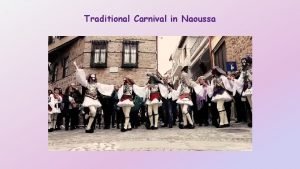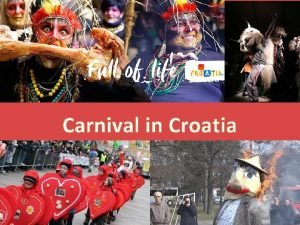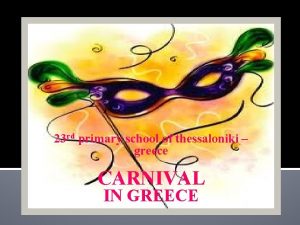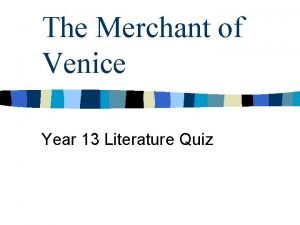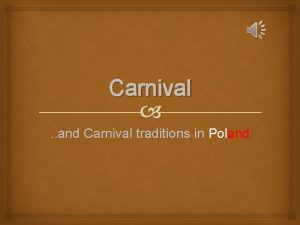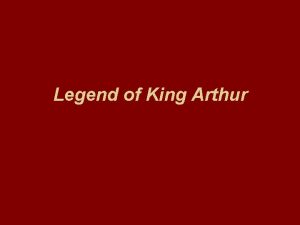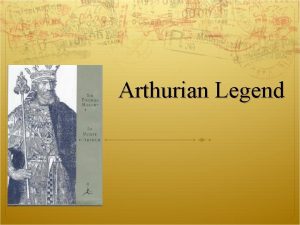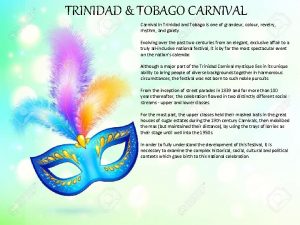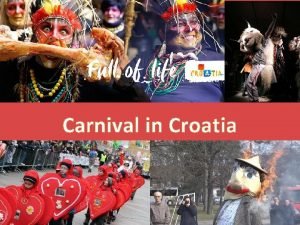Story and Legend The Carnival of Ivrea has












- Slides: 12


Story and Legend The Carnival of Ivrea has medieval origins. The story is about riots against various tyrants. A first riot was in 1194 when a young wife killed the tyrant who imposed the law of Jus Primae Noctis. A second riot of 1266 against the Marquis of Monferrato is remembered with La Preda in Dora

Now the “mugnaia”, the miller’s wife, Violetta, is the heroine who is the symbol of freedom for people. M Mm mm m

The general has a Napoleonic uniform. He remembers the union of every carnival: once each suburb had a different Carnival; under the Napoleonic invasions, in 1808, the generals united the carnivals.

rebellion against the tyrants The Phrygian cap worn during the carnival days dates back to Greek myths During the French Revolution it became the symbol of rebellion against the tyrants.

Mugnaia The sound track of the Carnival is composed by pipes and the drums that, in a red jacket and green trousers, with Phrygian hat, anticipate the ‘’Mugnaia’’ in the parade.

The Mayor and the Lord Chancellor The mayor represents the supreme chief of the governor of the common. The substitute Lord Chancellor, formal voice of manifestations, is dressed in black with a white shirt, a wig and a black hat cock-up. He is the guardian of the acts of Carnival for three days.

Storia Carnevale d’Ivrea The general is presented on 6 th January, the Epiphany day, accompanied by the fifes. Young boys and girls on hoseback, the “Abbà” represent the different districts. On Sunday before Carnival there is the reconciliation of the districts “Borghetto” and “San Maurizio” that once quarrelled to get the power On Fat Thursday the general takes the power of the city , he visits the Bishop and, in the evening, everybody dances in the ty streets wearing customs. On Saturday the “mugnaia” (miller’s wife) - secret up to the last minute – appears on the town hall balcony. Then there’s the procession of orange throwers (aranceri) and University goliardic groups, AUC created in 1924 and SOAS in 1961. On Sunday every district distributes a typical Carnival dish, fat beans. On Sunday morning there is the preda in the Dora river, the podestà launches one of the Castellazzo rocks into the river to celebrate the end of tyranny. In the Afternoon after the procession of “Mugnaia”, the orange battles starts in all the squares.

Carnival recipes Fat Beans Ingredients • 1 kg. of dry beans • 1 large onion • 400 g. of pork rind • 1 or 2 pig feet • some sausage to be cooked • some cloves • 1 stalk of celery • 1 carrot • 3 or 4 sprigs of rosemary • 2 cloves of garlic • Nutmeg • salt • pepper Preparation Soak the beans for at least 12 hours. After cleaning, washing and cutting pork rinds and legs sprinkle them with plenty of salt, roll them up tightly and tie with kitchen string for food. Add cloves in the onion. Mix the beans, the vegetables and all meat in the “tofeja”, a characteristic terracotta pot. Add water and put it in the oven for 6 hours at 160 degrees. When cooking is over, add rosemary and retrieves the needles, chop them finely with the cloves of garlic (peeled), then mix everything in the pot and stir. Salt and pepper to taste then serve the fat beans hot in personal bowls.

The teams on foot are now nine: Spades ’s Ace (1947), Death (1954) that fight in Piazza di Città; Tuchini (1964; Tucc one, and all for one, a motto during the anti-feudal revolts of the 14 th century in Canavese) that fight alone in Borghetto; Chess (1964) and Scorpions (1966, symbol of Arduino from Ivrea the tyrant killed by Violetta) that fight in Piazza Ottinetti; Panther (1966), Devils (1973) and Mercenaries (1974) who perform in Piazza del Rondolino and Credendari (1989) fighters of Piazza Freguglia. Teams Asso di Picche Spade Ace Morte Death Tuchini Scacchi Chess Scorpioni Scorpions Pantera Panther Diavoli Devils Mercenaries Credendari Spade Ace Tuchini Death Devils Scorpions Chess Panther Credendari Mercenaries

Carts The carts of arancieri are about forty, all very finely decorated and painted, and pulled by two or four horses. The battle of the oranges was born in the period between 1930 - 1940 as a kind act: the girls threw flowers and vegetables from balconies to the young boys who passed by. Carlo Alberto who had an exotic taste, changed the tradition into the battle of oranges. Their red colour evokes the fight against tyranny. The “Frigio” cap is compulsory: if you do not wear it the fighters throw you the oranges.

Pic and Pala - The “pic e pala”, (axe and shovel), the last couple of spouses plant the “scarlo”, symbol of the Ivrea’s carnival (cockade). Awards - On Shorve Tuesday there is the parades and the prize giving of the best team and wagons in the battle. The scarlo - Carnival finishes with the burning of the “scarlo”. The “scarlo” is a heater pole placed in the squares of the district. It represents the end of the Winter and it is a fertility ritual that dates backs to the 1300. The Funeral March - The last “scarlo” is in “Borghetto”, followed by the procession of the end of the carnival with only one fife for the funeral march. The last Shout - In Ottinetti square it is heard the last shout : See you on Tuesday at 1 o’clock for a new carnival. Polenta and cod – On Ash Wednesday morning, in Lamarmora Square is given polenta and cod to celebrate the start of Lent and fasting.
 Idrocentro tortona
Idrocentro tortona Every picture has a story and every story has a moment
Every picture has a story and every story has a moment Jayden tittle
Jayden tittle What happens at carnival in brazil
What happens at carnival in brazil Naoussa's carnival
Naoussa's carnival House on mango street vignette
House on mango street vignette 90 students went to a school carnival
90 students went to a school carnival Carnival definition geography
Carnival definition geography Carnival croatia
Carnival croatia Carnival akite
Carnival akite Cslide carnival
Cslide carnival Constance slides carnival
Constance slides carnival What news does antonio receive at the play's end
What news does antonio receive at the play's end




